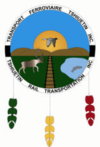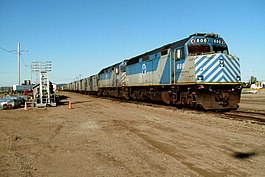Tshiuetin Rail Transportation
Tshiuetin Rail Transportation Inc. (reporting mark TSH, formerly TRT) is a rail company that owns and operates a 217-kilometre (135 mi) Canadian regional railway that stretches through the wilderness of western Labrador and northeastern Quebec.[2][3] It connects Emeril, Labrador with Schefferville, Quebec on the interprovincial boundary. The company also operates a 356-kilometre (221 mi) railway that connects Sept-Îles, Quebec to Emeril.[2] The company is the first railway in North America owned and operated by First Nations people,[4] specifically by the Innu Nation of Matimekush-Lac John, the Naskapi Nation of Kawawachikamach, and the Innu Takuaikan Uashat Mak Mani-Utenam.
| Tshiuetin | |||||||||||||||||||||||||||||||||||||||||||||||||||||||||||||||||||||||||||||||||||||||||||||||||||||||||||||||||||||||||||||||||||||||||||||
|---|---|---|---|---|---|---|---|---|---|---|---|---|---|---|---|---|---|---|---|---|---|---|---|---|---|---|---|---|---|---|---|---|---|---|---|---|---|---|---|---|---|---|---|---|---|---|---|---|---|---|---|---|---|---|---|---|---|---|---|---|---|---|---|---|---|---|---|---|---|---|---|---|---|---|---|---|---|---|---|---|---|---|---|---|---|---|---|---|---|---|---|---|---|---|---|---|---|---|---|---|---|---|---|---|---|---|---|---|---|---|---|---|---|---|---|---|---|---|---|---|---|---|---|---|---|---|---|---|---|---|---|---|---|---|---|---|---|---|---|---|---|
 | |||||||||||||||||||||||||||||||||||||||||||||||||||||||||||||||||||||||||||||||||||||||||||||||||||||||||||||||||||||||||||||||||||||||||||||
 A train at Sept-Îles departing for Schefferville | |||||||||||||||||||||||||||||||||||||||||||||||||||||||||||||||||||||||||||||||||||||||||||||||||||||||||||||||||||||||||||||||||||||||||||||
| Overview | |||||||||||||||||||||||||||||||||||||||||||||||||||||||||||||||||||||||||||||||||||||||||||||||||||||||||||||||||||||||||||||||||||||||||||||
| Other name(s) | North Wind | ||||||||||||||||||||||||||||||||||||||||||||||||||||||||||||||||||||||||||||||||||||||||||||||||||||||||||||||||||||||||||||||||||||||||||||
| Type | Heavy rail | ||||||||||||||||||||||||||||||||||||||||||||||||||||||||||||||||||||||||||||||||||||||||||||||||||||||||||||||||||||||||||||||||||||||||||||
| Status | Active | ||||||||||||||||||||||||||||||||||||||||||||||||||||||||||||||||||||||||||||||||||||||||||||||||||||||||||||||||||||||||||||||||||||||||||||
| Locale | Quebec and Labrador | ||||||||||||||||||||||||||||||||||||||||||||||||||||||||||||||||||||||||||||||||||||||||||||||||||||||||||||||||||||||||||||||||||||||||||||
| Coordinates | 53.0676959°N 66.2031418°W | ||||||||||||||||||||||||||||||||||||||||||||||||||||||||||||||||||||||||||||||||||||||||||||||||||||||||||||||||||||||||||||||||||||||||||||
| Termini | Emeril Schefferville | ||||||||||||||||||||||||||||||||||||||||||||||||||||||||||||||||||||||||||||||||||||||||||||||||||||||||||||||||||||||||||||||||||||||||||||
| Website | www.tshiuetin.net | ||||||||||||||||||||||||||||||||||||||||||||||||||||||||||||||||||||||||||||||||||||||||||||||||||||||||||||||||||||||||||||||||||||||||||||
| Operation | |||||||||||||||||||||||||||||||||||||||||||||||||||||||||||||||||||||||||||||||||||||||||||||||||||||||||||||||||||||||||||||||||||||||||||||
| Opened | December 1, 2005 | ||||||||||||||||||||||||||||||||||||||||||||||||||||||||||||||||||||||||||||||||||||||||||||||||||||||||||||||||||||||||||||||||||||||||||||
| Owner | |||||||||||||||||||||||||||||||||||||||||||||||||||||||||||||||||||||||||||||||||||||||||||||||||||||||||||||||||||||||||||||||||||||||||||||
| Technical | |||||||||||||||||||||||||||||||||||||||||||||||||||||||||||||||||||||||||||||||||||||||||||||||||||||||||||||||||||||||||||||||||||||||||||||
| Track length | 217 km (135 mi) | ||||||||||||||||||||||||||||||||||||||||||||||||||||||||||||||||||||||||||||||||||||||||||||||||||||||||||||||||||||||||||||||||||||||||||||
| Track gauge | 1,435 mm (4 ft 8 1⁄2 in) | ||||||||||||||||||||||||||||||||||||||||||||||||||||||||||||||||||||||||||||||||||||||||||||||||||||||||||||||||||||||||||||||||||||||||||||
| |||||||||||||||||||||||||||||||||||||||||||||||||||||||||||||||||||||||||||||||||||||||||||||||||||||||||||||||||||||||||||||||||||||||||||||
History


The railway began operations on December 1, 2005 with the conclusion of an agreement between the three owners of Tshiuetin Rail Transportation and the owners of the Quebec North Shore and Labrador Railway (QNSX), Rail Enterprises Incorporated and Iron Ore Company of Canada. Under this agreement, finalized in the fall of 2005, QNSX sold its Menihek Subdivision, for the nominal sum of Can$1.00.
Tshiuetin Rail Transportation took possession of the Menihek Subdivision "as is, where is". The company provides all passenger rail and limited freight service. The company will also provide passenger rail service on the remaining QNSX-owned line running from the port of Sept-Îles, Quebec to Emeril Jct (and on to Schefferville).
The Menihek Subdivision used to be part of the QNSX main line, constructed between 1951 and 1954. After mining activity in Schefferville ended during the 1980s, QNSX shifted its priority to the Sept-Îles to Labrador City line, and the Emeril Jct to Schefferville line had limited freight and subsidized passenger service for the remaining First Nations communities in the region.
The agreement between IOC and the three First Nations who own Tshiuetin Rail Transportation Inc. has resulted in the first aboriginal ownership of a railway line in Canada.
This railway (along with the QNSX line, Chemin de fer Arnaud, and Wabush Lake Railway) form an isolated railway network, as it does not interchange with any other rail lines on the North American network.
In media
The importance of the line is documented in Caroline Monnet's 2016 short film Tshiuetin.[5]
On July 6, 2020, Chloë Ellingson of the New York Times published an extensive pictorial essay on the railroad.[4]
References
- "Rail Map". Tshiuetin Rail Transportation.
- "Fact Sheet" (PDF). CCN Matthews. Archived from the original (PDF) on 2015-12-26. Retrieved 2020-06-23.
- "IOC colours" (PDF). CCN Matthews. Archived from the original (PDF) on 2015-11-04. Retrieved 2020-06-23.
- Ellingson, Chloë (2020-07-06). "Commuting, and Confronting History, on a Remote Canadian Railway". The New York Times. ISSN 0362-4331. Retrieved 2020-07-06.
- Monnet, Caroline (2016). Tshiuetin. Canadian Broadcasting Corporation. Retrieved 2017-03-01.
- Arkus, Mike (2014-10-20). "Now This Here's the Story about the Tshiuetin Line". HuffPost. Retrieved 2020-05-23.
Further reading
- "Commuting, and Confronting History, on a Remote Canadian Railway The Tshiuetin line, the first railroad in North America owned and operated by First Nations people, is a symbol of reclamation and defiance for the communities it serves."